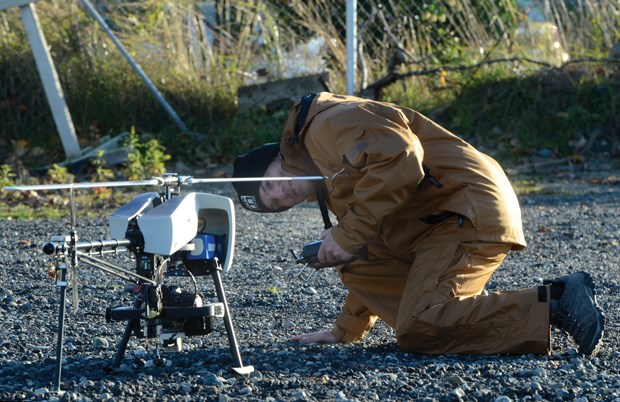In a floating aluminum boatshed serving as his Mosquito Creek office, Jason Calla is trying to help First Nations youth gain a foothold in a burgeoning technology.
Unmanned aerial vehicles, often called drones, provide a way for First Nations youth to steward the environment while working in a cutting edge job, according to the Squamish Nation entrepreneur.
First Nations are sometimes excluded from a booming economy - in part because of a disparity in values, Calla explained. An ecologically minded youngster might be reluctant to work for an oil company that's "wreaking havoc on the environment," according to Calla.
"There's some economic opportunities out there, but sometimes First Nations aren't involved."
For Calla, flying robots could be the answer.
"These ones don't drop bombs," he said. "They have cameras on them."
Calla's company, iRobotic
Robotic Aviation on the project.
ING manufactured and supplied drones, also known as "UAVs", to the Canadian military, beginning in 2008. The drones clocked around 32,000 hours of flight time in Afghanistan, according to company director Luiz Araujo, who spoke to the North Shore News in March.
Asked about complicating his business model with environmental concerns, CEO Ian Glenn laughed.
"I'm not as hard-nosed a business guy as you might think," he said.
The company's drones have been used to detect gas leaks and also to gauge flood risk by monitoring river levels in Sherbrooke, Que.
Glenn is exploring a way to bring jobs to northern communities as part of what he calls a "social enterprise."
"We have very practical tools, we're going to put them in the hands of that Xbox generation and I think they will amaze us," Glenn says.
The drones provide near-instant video feedback to the operator, who controls the mini-helicopters by laptop.
The technology could be used to monitor migrating whales or goods in transit.
"There's $2.1 trillion of resources in the province of Alberta that needs to get to market if it's going to be realized. How can we do that safely? And who better to empower to do that than First Nations?" Glenn asked.
It might not be too long before a project gets off the ground, according to Calla.
"We have people in ING Robotic that are ready to start training these kids," he says.
The instructor would likely be Gregory Benoit, an air force veteran whose experience includes "(sitting) in the back of a (patrol plane) and (directing) jets around it at 700 knots while he was travelling at 600 knots," according to Glenn.
Youth can learn to pilot the drones - one of which can reach a top speed of 80 kilometres per hour - in a relatively short time, according to Calla.
The drones follow a flight path set by GPS coordinates and cost in the neighbourhood of $200 to $300 per hour to operate.
Calla said he's hopeful one of the startup company's first contracts would involve tracking herds of migrating caribou in Nunavut.
Asked who will pay for the project, Glenn suggested
Ottawa might play a role.
"There's a certain amount that the federal government has a responsibility for," he said.
Calla envisions the drones also monitoring forest fires and overlooking harbour traffic.
"I'm at the marina myself, I don't want to see the Burard Inlet have tanker incidents," he said.
Drones present a low-cost, low-risk method of monitoring, according to Calla.
"If one of these things crashes: they're not very big, you're not going to lose a life, and they're about the cost of a (Ford) F-150."
Besides using "less fuel than your lawnmower," drones also provide better detail than a satellite, according to Glenn.
The technology could unite First Nations bands, according to Calla.
"There's lots of different First Nations and we have differences in our culture like language and different customs throughout the province, but I think there's one consistent feature of a lot of First Nation cultures: and that's a high value on the environment."



